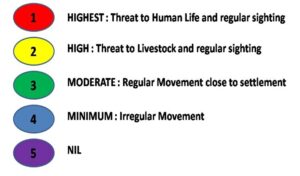
Dr. Joy Gardner
Chairman, Hope & Beyond
A small river named Duden flows by their place and supplies it with the necessary
- Phone:+1 (859) 254-6589
- Email:info@example.com
Introduction
Indian Leopard:
The Indian leopard (Panthera pardus fusca) is a leopard subspecies widely distributed in the Indian subcontinent. The species Panthera pardus is listed as Vulnerable on the IUCN Red List because populations have declined following habitat loss and fragmentation, poaching for the illegal trade of skins and body parts, and persecution due to conflict situations.[6] In 2014, a national census of leopards around tiger habitats was carried out in India except the northeast. 7,910 individuals were estimated in surveyed areas and a national total of 12,000-14,000 speculated.[2]
Study Area:
Nahargarh Wildlife Sanctuary and Jhalana Conservation Reserve, Jaipur, Rajasthan 26.9260° N, 75.8235° E (Degree Decimal). These two forest divisions are considered to be the most leopard-populated regions of the Jaipur Forest Area. Most of the leopard conflicts with humans occur in these two forest divisions as there is ever increasing presence of human settlements close by. The forest vegetation that accounts for 8.19% in Rajasthan is deciduous and has thorny trees, grasses and shrubs.[9] The tree species found are Babool, Dhonk, Amaltas, varied species of Acacia and Khejri, etc. Numerous species of herbs and plants that have medicinal value are very common here. The forests consist of sandstone and quartzite rocks and the foliage typically symbolizes the sultry dry deciduous and muggy bristle forests. At present, there are approximately 18 leopards in Jhalana Reserve Forest and 8 leopards in Nahargarh Wildlife Sanctuary and according to the forest department there are 26 leopards in Jaipur forest area besides deer, blue-bull, fox, wolf, sambhar, hyena, jackal and several other species.
Problem Overview:
The leopard is an important animal in the ecosystem of Jaipur forest area. It occupies the highest trophic level. The main problem arising for the survival of the leopards in Jaipur forest area is the illegal/legal encroachment by humans in the fringe area of the forest due to which this magnificent carnivore has started moving out of the forest and has been sighted frequently in and around the villages of the forest. The intensity of these sightings and encounters has risen over the years and is still increasing. Proper mitigation techniques and conservation guidelines need to be implemented in order to safeguard these magnificent carnivores. As an animal which has learnt to adapt itself to the fast changing landscape, it is also the most maligned in the Indian context, bludgeoned to death, poisoned or even burnt alive, by the so-called “civilized society.” The animals are hard-pressed from all directions, forcing them to come into conflict with humans. Rise in human settlements around the Jaipur forest area has increased human interference inside forest area. The mere presence of a leopard in an area does not mean that it has to be removed. Certain monitoring protocols have to be devised in order to mitigate this problem.
Review of Literature

Scientific and Indigenous Mitigation Techniques:
 Fig 1.2 Installed Halogen light on village house roof top
Fig 1.2 Installed Halogen light on village house roof top

 Fig 1.3 “I-Cow technique” on cattle of affected villages
The outcome was that the cattle with eyes painted on their rump were not attacked by leopards. Not a single case of leopard attack has been seen since this technique was implemented. We analyzed the results of the situation before and after this technique were carried out as well as compared the threat level to cattle with and without rumps painted with eyes.
Fig 1.3 “I-Cow technique” on cattle of affected villages
The outcome was that the cattle with eyes painted on their rump were not attacked by leopards. Not a single case of leopard attack has been seen since this technique was implemented. We analyzed the results of the situation before and after this technique were carried out as well as compared the threat level to cattle with and without rumps painted with eyes.

- Human disturbances have caused the leopard to wander over very large territories to satisfy their food requirements and they may not remain more than a few days in a given locality.[1]
- The increased evidences of livestock predation and human conflicts indicates depleted natural resources with poor prey base and that urgent conservation measures by reducing habitat degradation & to restore the population of prey species are required. [7]
| Date/Month/Year | Area | Leopard case | Attack | Dead/Alive |
| 29/7/2011 | Galta ji | Entered house/ Beaten to death | — | Dead |
| 13/10/2012 | Chandwaji | Road Kill | — | Dead |
| 19/9/2013 | Amore (Nahargarh Biological Park) | Unknown | — | Dead |
| 7/10/2013 | Jamwa Ramgarh | Territorial fight | — | Dead |
| 28/10/2013 | Looniawaas | Entered house/Rescued | 4 persons mauled | Alive |
| 25/11/2013 | Bandh ki Ghati (Amer) | Internal injuries (Brain, Liver, Lung) | — | Dead |
| 22/4/2015 | Virat Nagar | Entered village/Beaten to death | 3 persons mauled | Dead |
| 6/11/2015 | Milaap Nagar | Entered house/Rescued | — | Alive |
| 21/2/2016 | Jaisinghpura Khor | Iron Trap by Poachers/Rescued | — | Alive |
| 8/3/2016 | Galta forest | Leopard cub entered human settlement/Rescued | — | Alive |
| 15/6/2016 | Khole ke Hanuman | Found dead due to starvation | — | Dead |
| 8/7/2016 | Jamwa Ramgarh | Electrocuted | — | Dead |
| 21/12/2016 | University of Rajasthan, Jaipur | Entered University campus/Rescued | — | Alive |
| 9/1/2017 | Daulatpura, Manpura | Entered village/Beaten and Tied to tree by villagers/Rescued | 1 boy mauled | Alive |
| 6/3/2017 | JLN Marg, Jaipur | Entered public park/residing there/park closed | — | Alive |
| 18/5/2017 | Bassi | Entered human settlement/Rescued | — | Alive |
- Trashing speculation following the spate of recent incidents of human-leopard conflict which indicated that leopard numbers were on the rise, a study conducted by three wildlife scientists has found that the leopard population, on the contrary, has declined by a whopping 70-80% over the past 100 years. When the interests of human beings and wildlife are at odds, sometimes nobody wins. In rural India, several million people rely on crops and livestock for income. A roaming tiger, leopard, elephant, or pig can pose a threat to their livelihood, not to mention human life. The conflict plays out along the “hard edges,” areas where nature reserves end and villages begin.[3]
- To avert such conflicts, state wildlife departments must launch awareness drives among local residents about the possible causes of such attacks and the preventive measures to be taken so that losses in terms of livestock, humans as well as leopards can be minimized. Residents should be paid ex-gratia in case of attacks/deaths of humans and loss of livestock at the earliest [8].
- Halogen Light Technique: Villages situated in fringe area of Jaipur forest have been witnessing regular leopard sightings. These leopards attack livestock after watching them carefully from a safe distance. Due to the absence of proper illumination by lights in these areas, leopards remain elusive until the attack is carried out. Installation of halogen lights on the roof the houses and livestock sheds facing the boundary and bushy forest area was the first mitigation technique applied.
- I-Cow Technique: In this technique the structure of eyes is painted on the rump of cattle which dwell near the forest area. This idea is already present in nature; many animals use such mechanism to defend themselves from the enemy. Animals like Spectacled Cobra (Naja naja), Four-eyed butterfish (Chaetodon capistratus), Owl Butterfly (Caligo beltrao), etc use this technique to confuse their predator.
- Metallic Livestock Sheds: To reduce leopard dependency on livestock metal sheds were constructed for cattle in some villages. A guideline was given to villagers how to construct metallic livestock sheds in place of their thatch roofed cages. Earlier the cattle were being kept in temporary sheds which are not very safe during leopard attacks. These domestic animals were very easy for the leopards to kill and eat.
- ‘Cattle bell’ technique: Villagers were instructed to tie cattle bells around the necks of few members in a shed every night. This technique was carried out as an alarm for shepherds in case of a leopard attack wherein anxious movement inside the shed would draw the attention of shepherd.

Fig 1.1 Scale of Human Leopard Conflict zones
We conducted surveys and marked waypoints in GPS of the conflict areas. We surveyed 79 villages in fringe areas of these two forests, out of which 18 villages showed rare or no leopard movement, 22 villages are suffering from conflict situations, but 39 villages are in major conflict zones. Table 1.2 Number of villages and colonies in identified conflict zones| Zone |
Number of Villages and Colonies |
| Zone 1 | 08 |
| Zone 2 | 31 |
| Zone 3 | 19 |
| Zone 4 | 03 |
| Zone 5 | 18 |
- Halogen Light Technique: Installation of halogen lights on the roof of houses and livestock sheds facing the boundary and bushy forest area illuminated the hideout spots of leopards during the night time. Leopards have a habit of scanning their territory where they wish to conduct an ambush. In these conflict hotspots, leopards stopped lying in wait for their attack victim around attack-prone houses in forest fringe areas. This technique discouraged leopards to enter the area.
 Fig 1.2 Installed Halogen light on village house roof top
Fig 1.2 Installed Halogen light on village house roof top
- I-Cow Technique: In this technique the structure of painted eyes on the rump of 50% cattle population in fringe communities enabled us to compare the rate of leopard attacks between cattle with and without the I-Cow technique. This novel technique acted like a ‘surprise element’ for leopards which attack cattle while grazing in forest fringe areas.

 Fig 1.3 “I-Cow technique” on cattle of affected villages
The outcome was that the cattle with eyes painted on their rump were not attacked by leopards. Not a single case of leopard attack has been seen since this technique was implemented. We analyzed the results of the situation before and after this technique were carried out as well as compared the threat level to cattle with and without rumps painted with eyes.
Fig 1.3 “I-Cow technique” on cattle of affected villages
The outcome was that the cattle with eyes painted on their rump were not attacked by leopards. Not a single case of leopard attack has been seen since this technique was implemented. We analyzed the results of the situation before and after this technique were carried out as well as compared the threat level to cattle with and without rumps painted with eyes.
| Table 1.3 ‘I-Cow’ Status in Jhalana and NWLS | |||||
| Till 30th December 2016 | Till February 2017 | ||||
| Animal | Adult | Sub-adult / Baby | Total | Mark Still Found | Repeated |
| Cow | 154 | 123 | 277 | 76 | 201 |
| Buffalo | 39 | 21 | 60 | 9 | 51 |
| Goat | 257 | 54 | 311 | 37 | 274 |
| Sheep | 115 | 32 | 147 | 21 | 126 |
| Donkey | 7 | 1 | 8 | 0 | 8 |
| Total | 572 | 231 | 803 | 143 | 660 |
| Total “I-Cow” | Total + Repeated | 1463 | |||
- Metallic Livestock Sheds: We encouraged shepherds to build metallic livestock sheds for their animals with the aim of better protection from predation by leopards. A better alternative was construction and installation of wire mesh cages with thorny bushes along the outer surface of the livestock sheds. This technique discouraged leopards to come near the livestock sheds both during the day as well as at night time. These metallic livestock sheds have been very resourceful and have replaced older thatch-roofed and wooden cages in these villages. After making these sheds leopard movement in these villages is now reduced.

Fig 1.4 Installation of Metallic Livestock Sheds in affected villages
- ‘Cattle bell’ technique: Villagers were instructed to tie cattle bells around the necks of few members in a shed every night, so that even if some leopard strayed into the neighborhood at night, these few cattle with bells around their necks would act like an alarm. This was most useful in those houses in which villagers could not afford cemented base for metallic livestock sheds and there were chances for the leopard to dig around the wired mesh and enter the shed. The villagers were instructed to remove the cattle bells every morning before they went for grazing in order to avoid every possible chance for the leopard to follow the cattle bell sound in the forest fringe area while the cattle were grazing.
- Anwar Maan, M. & A. Aleem Chaudhary, (2000). Tiger paper, 27 (4), 14-17.
- Bhattacharya, A. (2015). “Finally, India gets a count of its leopard numbers: 12,000-14,000”. Times of India. Retrieved 20 February 2016.
- Karanth, K. (2013). Mitigating the Human-Wildlife Conflict. Farmers in India cope with dangerous wildlife. nationalgeographic.com /news/2013/08/130815.
- Mazoomdaar, J. (2015). First ever leopard census: India should not feel too smug too soon. The Indian Express, 7 September 2015.
- Menon, V. (2014). Indian Mammals: A Field Guide. Gurgaon, India: Hachette India. ISBN978-93-5009-761-8.
- Srivastava, S. (2000). Indian Forester, 123, 1128-1135.
- Stein, A. B., Athreya, V., Gerngross, P., Balme, G., Henschel, P., Karanth, U., Miquelle, D., Rostro, S., Kamler, J. F., Laguardia, A. (2016). “Panthera pardus”. IUCN Red List of Threatened Species. Version 2016.1. International Union for Conservation of Nature.
- Tushar, R. Human-leopard conflict: big cats losing battle for survival, Down to Earth, 13 March 2014.
- rajforest.nic.in